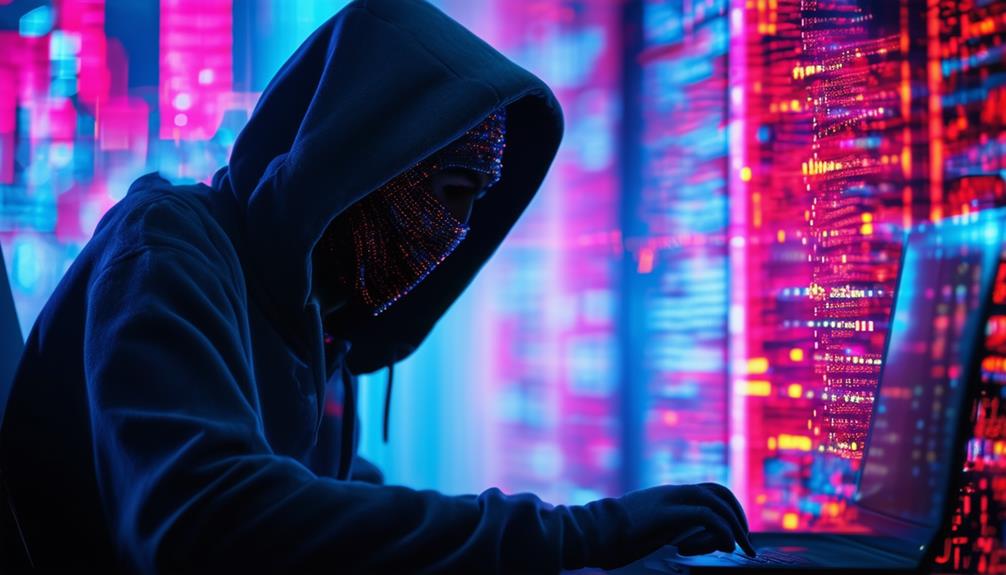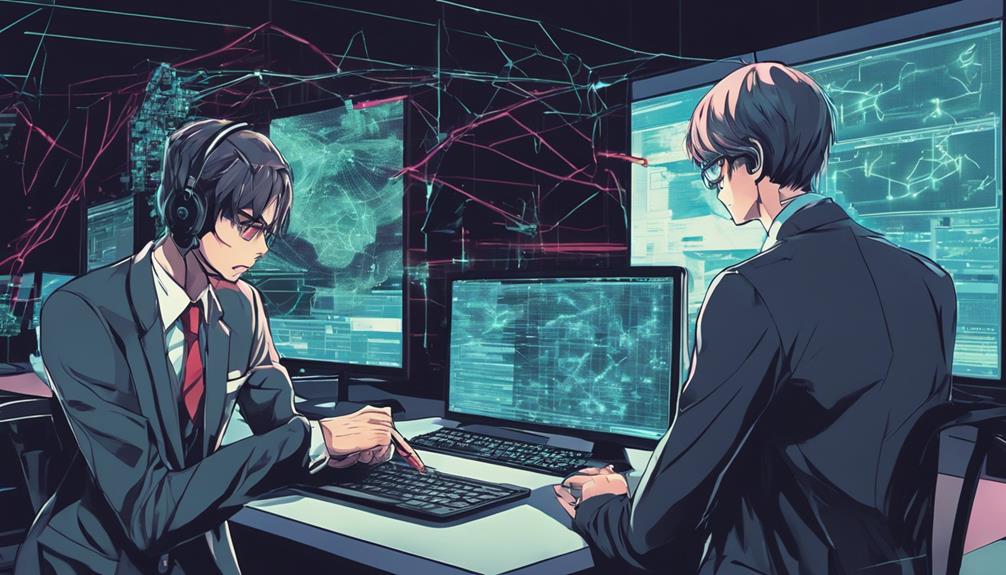In this high-stakes showdown, Red Teams simulate real-world cyberattacks, testing your defenses with tactics like penetration testing and social engineering, while Blue Teams work to detect and respond to threats in real time. This continuous battle reveals vulnerabilities, sharpens your security skills, and helps you adapt faster to emerging threats. If you want to turn these intense exercises into a strategic advantage, there’s more to explore on how this process can transform your defenses.
Key Takeaways
- Red Teams simulate realistic cyberattacks to identify vulnerabilities, while Blue Teams defend and detect threats proactively, creating a dynamic security environment.
- Collaboration and regular exercises between Red and Blue Teams strengthen organizational cybersecurity defenses through offensive and defensive synergy.
- These adversarial simulations reveal security gaps, improve incident response, and adapt defenses to evolving threat tactics.
- Metrics and continuous monitoring help organizations measure security maturity and refine strategies based on Red and Blue Team insights.
- Cultivating a security-aware culture with ongoing testing and updates ensures resilient defenses against emerging cyber threats.
Understanding the Roles of Red and Blue Teams
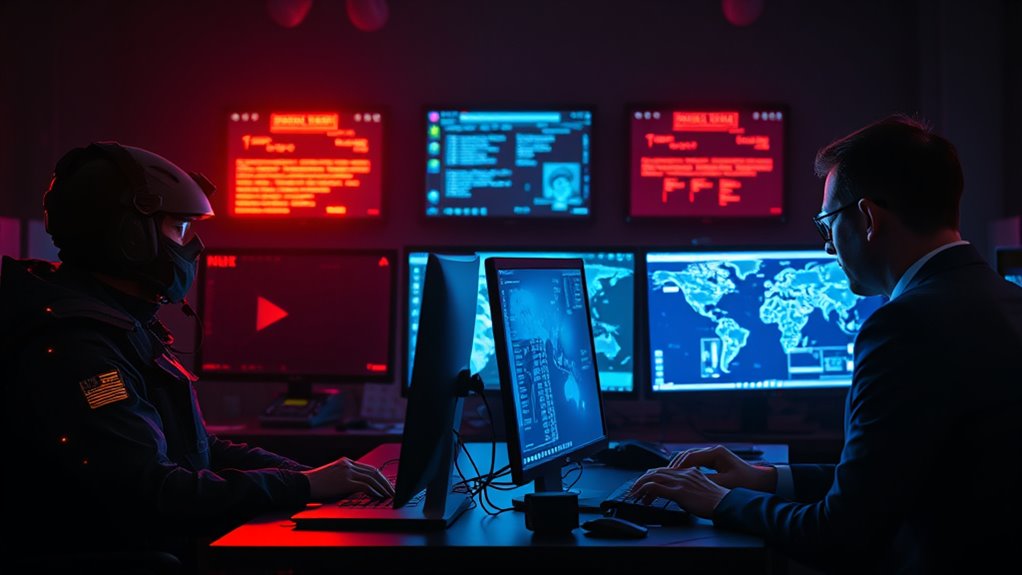
Understanding the roles of Red and Blue Teams is essential for a thorough cybersecurity strategy. Red Teams simulate real-world cyberattacks, using tactics like penetration testing, social engineering, and vulnerability scanning to identify security weaknesses. They actively attempt to exploit vulnerabilities, gain unauthorized access, and test defenses under realistic conditions. Their goal is to uncover gaps before malicious hackers can. Blue Teams, on the other hand, defend the organization’s infrastructure by continuously monitoring, detecting, and responding to threats. They use tools like SIEMs, IDS/IPS, and EDR to identify attacks, contain incidents, and strengthen security measures. Both teams operate with different mindsets—Red Teams are offensive, creative, and problem-solving, while Blue Teams are defensive, analytical, and vigilant. Their collaboration enhances overall security resilience.
The Purpose Behind Simulated Cyber Attacks

Simulated cyber attacks serve a crucial purpose in strengthening an organization’s security posture by revealing vulnerabilities before malicious actors can exploit them. They mimic real-world attacker tactics to uncover misconfigurations, unpatched software, and insecure protocols, helping you prioritize remediation efforts. This proactive approach reduces organizational risk by addressing security gaps early. Simulations also test and improve incident response capabilities, allowing your team to practice detection, containment, and mitigation in a controlled environment. They identify weaknesses in your response plans and refine workflows, boosting confidence and preparedness. Additionally, these exercises enhance security awareness among employees, turning them into active defenders. By understanding current attacker behaviors and techniques, you can tailor defenses and stay ahead of evolving threats, ultimately fortifying your organization’s cybersecurity resilience. Regular testing plays a vital role in maintaining an effective security posture in an ever-changing threat landscape.
Offensive Strategies Employed by Red Teams
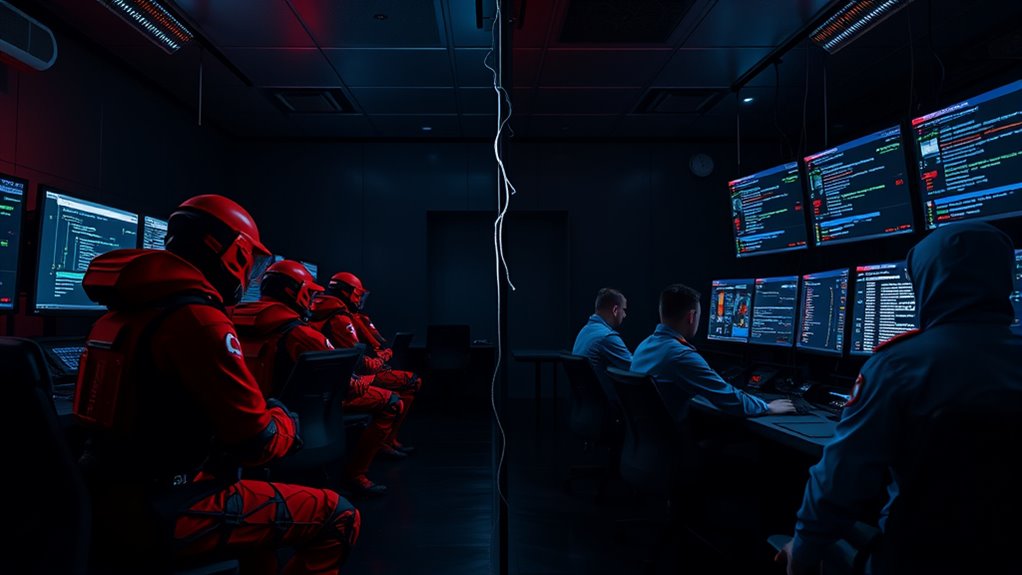
Red teams employ a range of offensive strategies to mimic the tactics used by real-world adversaries. They imitate attack methods, using custom tools like scripts, exploit frameworks, and social engineering kits to simulate current cyber threats. Their goal is to test detection and response capabilities by replicating trends such as AI-driven attacks. They conduct all-encompassing reconnaissance through OSINT, social media, and network scans, identifying technical and human vulnerabilities. Exploiting these weaknesses, they deploy phishing, malware, or stolen credentials to gain initial access, using stealth to avoid detection. Once inside, they escalate privileges and move laterally, mimicking persistent threat actors. These strategies reveal security gaps that traditional testing might overlook.
| Strategy | Tactics | Purpose |
|---|---|---|
| Imitation of Adversaries | Custom exploits, social engineering | Test detection capabilities |
| Reconnaissance | OSINT, network scans | Find vulnerabilities |
| Exploitation | Phishing, malware, exploits | Achieve initial access |
Defensive Tactics Used by Blue Teams

You rely on continuous monitoring practices like SIEM and EDR tools to spot threats in real-time, helping you catch issues before they escalate. Threat hunting strategies, such as behavioral analytics, allow you to proactively identify anomalies and uncover hidden risks. By integrating these tactics, you strengthen your defenses and stay ahead of potential attackers. Employing these proactive measures enables your team to detect and respond to threats more effectively, reducing the window of opportunity for cybercriminals. Additionally, understanding the steps in ethical hacking process can help refine your defensive strategies and anticipate attacker methodologies.
Continuous Monitoring Practices
Continuous monitoring is essential for detecting threats early and preventing damage before it escalates. You should implement real-time observation of your network activity, using tools like Security Information and Event Management (SIEM) systems that gather data from firewalls, intrusion detection systems, and other sources. Regular log analysis helps you identify indicators of compromise, while network traffic analysis spots anomalies like unusual data flows or unauthorized access attempts. Endpoint security monitoring checks individual devices for signs of compromise, adding another detection layer. By maintaining these practices, you can quickly identify suspicious activity, respond swiftly, and minimize damage. Maintaining continuous monitoring is critical for early threat detection and operational resilience. Consistent monitoring creates a proactive defense, ensuring threats are caught early and mitigated before they cause significant harm.
Threat Hunting Strategies
Threat hunting strategies are essential for proactively identifying hidden threats before they cause significant damage. You start by integrating threat intelligence—collecting and analyzing the latest data on emerging threats, adversary tactics, and IOCs. Using threat intelligence platforms helps prioritize sector-specific risks, guiding focused investigations. Link this intelligence to your hunting tools to correlate suspicious activity with known threats, enabling faster detection. Employ hypotheses driven by intelligence to target realistic attack scenarios, reducing false positives. Advanced detection techniques involve manual in-depth explorations into network traffic, logs, and system data, searching for subtle anomalies and behavioral patterns that evade traditional tools. Incorporate dark web monitoring and external sources for early indications. Threat intelligence integration is a cornerstone of effective threat hunting, providing context and clarity to complex data. Additionally, leveraging contextual analysis enhances the accuracy of identifying genuine threats amidst false alarms. Automation and collaboration accelerate response times, making your threat hunting more effective and resilient against evolving cyber threats.
The Benefits of Regular Red and Blue Team Exercises

Regular Red and Blue Team exercises offer significant benefits by actively strengthening your organization’s cybersecurity defenses. These exercises reveal vulnerabilities through simulated attacks, helping you identify weaknesses before malicious actors do. Blue Teams respond to these threats, sharpening their defensive skills and improving incident response strategies. The collaboration fosters better communication and teamwork, creating a unified security effort. The integration of advanced security measures into these exercises allows organizations to test the effectiveness of new tools and strategies in real-world scenarios. Regular practice also enhances staff awareness of human risks, such as social engineering, and develops your security expertise. Operationally, these exercises optimize resource allocation and streamline security measures, ensuring faster detection and containment. Technologically, they promote the deployment of advanced threat detection tools and adaptive security measures. Furthermore, these exercises help organizations stay ahead of emerging threats by testing defenses against the latest attack techniques. Overall, consistent exercises boost your organization’s cyber readiness, resilience, and ability to adapt to evolving threats.
Key Metrics for Measuring Security Maturity

Measuring your organization’s security maturity is essential for understanding how well your cybersecurity practices are evolving. Maturity levels range from Unstructured (Level 1) to Optimized (Level 5), guiding your growth. Quantitative metrics track vulnerability detection, incident response times, and trend improvements, providing clear indicators of progress. Cybersecurity scoring systems assign scores from 0 to 4, enabling consistent comparisons over time. Key metrics fall into categories like governance, risk management, security engineering, and incident response. Use these to identify gaps, justify investments, and refine strategies. Here’s a quick snapshot:
| Maturity Level | Focus | Key Metric Example |
|---|---|---|
| Level 1-2 | Basic processes, nascent culture | Vulnerability frequency |
| Level 3-4 | Standardized, monitored, managed | Mean Time to Remediate (MTTR) |
| Level 5 | Continuous improvement and optimization | Security Confidence Score |
Common Challenges and Ethical Considerations
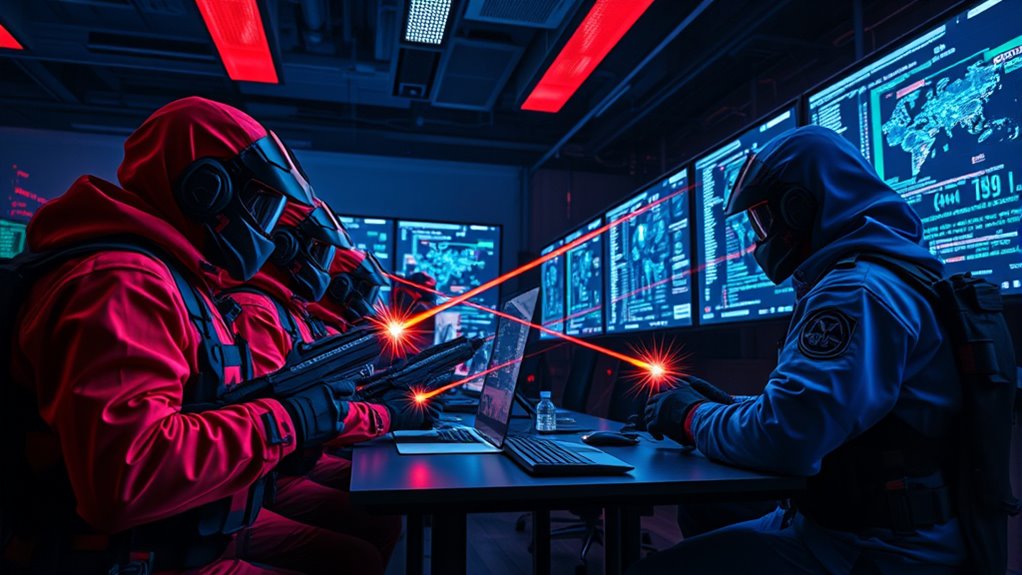
Effective coordination and communication are vital for the success of red and blue team exercises, yet many organizations face challenges in aligning their efforts. Miscommunication can lead to misunderstood attack scenarios or responses, while timing conflicts reduce the realism of simulations. Incompatibilities in reporting formats hinder clear sharing of findings, and divergent objectives between offensive and defensive teams can cause friction. Maintaining ongoing collaboration over long exercises strains resources and focus. Additionally, handling false positives and negatives presents challenges: alert fatigue from false alarms, overlooked simulated attacks, and difficulties balancing detection sensitivity. Ethical concerns also arise, including risks of system disruption, the need for pre-approval, and safeguarding sensitive information. These issues demand careful management to ensure effective and responsible testing. Clear communication channels are essential to facilitate timely and accurate information exchange between teams, and establishing standardized procedures can help mitigate reporting incompatibilities.
Integrating Findings Into Organizational Security Policies

Integrating red and blue team findings into organizational security policies is essential for closing security gaps and adapting to evolving threats. Red team exercises reveal real-world attack vectors and vulnerabilities that need immediate attention. Detailed reports highlight technical flaws and gaps, guiding policy updates on access controls, endpoint protections, and incident response protocols. Translating these insights into clear, written policies guarantees consistent implementation and employee guidance. Blue team feedback on detection and response effectiveness further refines security controls and monitoring policies. Collaborative debriefs synthesize offensive and defensive perspectives, clarifying vulnerabilities and establishing actionable remediation steps. Incorporating lessons learned into risk assessments and training ensures your organization stays ahead of threats, fostering a proactive security posture aligned with compliance standards like NIST and ISO. Regular review and updating of security policies are crucial to maintaining effectiveness amid the rapidly changing threat landscape, especially as organizations adapt to emerging vulnerabilities and incorporate new security technologies.
Building a Culture of Continuous Security Improvement

Building a culture of continuous security improvement requires organizations to embed proactive monitoring, assessment, and learning into everyday operations. You should implement monitoring agents across all applications, servers, networks, and databases to detect threats early. Choose monitoring tools aligned with your goals to gain thorough visibility. Centralize data in dashboards for ongoing analysis and swift anomaly detection. Conduct regular vulnerability scans and risk assessments based on monitoring outputs. Expand monitoring to third-party vendors to address external risks. Establishing a monitoring policy and procedure is essential to maintain consistency and effectiveness in these efforts.
Embed proactive monitoring and continuous assessment to foster a resilient security culture.
- Set a baseline of normal user behavior to spot insider threats.
- Use continuous tools to flag deviations and unusual activities.
- Limit access privileges to critical data, reducing insider threat potential.
- Incorporate behavioral analytics into risk assessments and incident handling.
- Regularly update your monitoring strategies to adapt to evolving threats and ensure the effectiveness of your security posture by integrating insights from security technology and recent threat intelligence.
Frequently Asked Questions
How Do Red and Blue Teams Coordinate During Joint Exercises?
During joint exercises, you coordinate by establishing clear communication channels and shared objectives. Both teams contribute their expertise, sharing attack insights and defense strategies in real time. You collaborate on threat modeling and vulnerability assessments, ensuring roles are well-defined to prevent overlaps. You also participate in feedback sessions afterward, discussing findings and improvement areas. This active collaboration helps you adapt tactics, strengthen defenses, and foster a culture of continuous learning and shared responsibility.
What Tools Are Most Effective for Red Team Simulations?
Imagine a chess game where each move reveals a new strategy—your red team needs the right tools to outmaneuver defenses. You’ll find Cobalt Strike essential for stealthy post-exploitation, while Sliver’s cross-platform support keeps your options open. Mythic streamlines operations, and PoshC2 offers stealthy communication. Metasploit remains a versatile staple. Together, these tools help you simulate real attacks, sharpening your tactics and revealing vulnerabilities before adversaries strike.
How Can Organizations Ensure Ethical Boundaries Are Maintained?
You can guarantee ethical boundaries by establishing clear guidelines and legal boundaries before testing. Obtain explicit consent from stakeholders and define a detailed scope to prevent unintended harm. Use authorized tools only, follow recognized frameworks, and keep oversight through continuous monitoring. Regularly review agreements, involve legal counsel, and promote a culture of professionalism and transparency. This approach helps maintain trust, accountability, and adherence to ethical standards during your security exercises.
What Are Common Signs of a Cybersecurity Breach During Exercises?
During exercises, you’ll notice signs like unusual network activity, such as spikes or drops in traffic at odd hours, and unexpected login attempts from unfamiliar locations. System slows down or crashes, and you might see unauthorized changes in settings or files. Suspicious emails, failed multi-factor authentications, or new admin accounts also signal potential breaches. Monitoring these indicators helps you identify and respond quickly to security threats during simulations.
How Often Should Organizations Conduct Red and Blue Team Drills?
You should aim for at least one full-scale red team exercise annually, as this helps you stay ahead of evolving threats. Blue team drills should be continuous, ensuring your defenses adapt in real time. Regular testing reduces breach costs by 13%. Tailor the frequency to your organization’s size and risk appetite, balancing offensive and defensive tactics. Consistent exercises sharpen your response, making your security posture more resilient over time.
Conclusion
Now, as you prepare to strengthen your defenses, remember that the real challenge lies ahead. Will your blue team adapt quickly enough to the red team’s relentless tactics? Every exercise uncovers vulnerabilities you never knew existed—are you ready to face what’s next? The battle between offense and defense is ongoing. Stay vigilant, keep evolving, and don’t let your guard down—because in cybersecurity, the next threat is always just around the corner.



